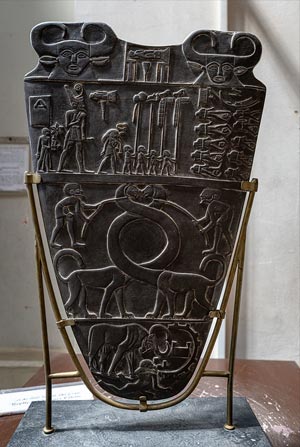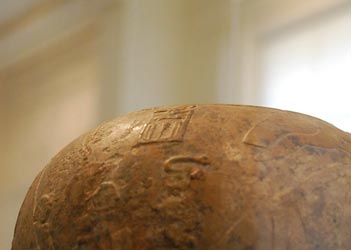The First Pharaoh of Ancient Egypt
Narmer, one of the greatest figures in human history, is believed to be Ancient Egypt's first pharaoh. He is widely recognized for unifying Upper and Lower Egypt. Besides, he laid the foundation for one of the longest-lasting and most influential civilizations ever known to humanity.
Narmer's reign significantly shaped society throughout Ancient Egypt's long history. However, controversy remains surrounding both his identity and achievements. In this article, we delve further into exploring his life, rule, achievements, and legacy.
Unraveling Egypt's First Pharaoh: Was it Menes, Narmer, or Aha?
The historical and archaeological debate has long centered around identifying the first Pharaoh of Egypt. According to Egyptian historian Manetho, Menes founded a unified Egyptian state. The state combined Upper and Lower Egypt under a single monarchy.
However, some scholars suggest that Narmer or Aha could have been holders of this position. The two names feature the first and second rulers, respectively, of the First Dynasty.

© Marat Dakunin - Narmer palette
There is little mention of Menes in the archaeological record. Rather, evidence points towards Narmer and Aha as possible candidates for his title as the first pharaoh. A Narmer Palette from Hierakonpolis shows King Narmer wearing both Upper and Lower Egypt crowns. At the same time, an ivory plaque bearing his name, Aha and Men (Menes), is evident at Naqada.
Umm el-Qaab Seal Impressions reveal the first six rulers of the First Dynasty. These include Narmer, Aha, Djer, Djet, Den, and Queen Merneith. This complicates the identification further. Menes has not been mentioned in such early records, so his true identity remains to be discovered.
The Unification of Egypt
While it is widely accepted that Narmer was the founder of the 1st Dynasty, there is insufficient evidence to assert this beyond any doubt. Ancient Egyptian sources, such as the Palermo Stone, must clearly account for the first king of unified Egypt.
It is believed that Narmer and Menes were two different names for the same individual. Narmer is assumed as his birth name, and Menes is an honorific title. Analysis of multiple sources points to Narmer as the first Pharao.
Narmer is credited for unifying Upper and Lower Egypt, which had existed as separate kingdoms for centuries. This momentous event in world history led to a single, centralized monarchy that would endure for millennia. It was likely accomplished through military conquest and diplomatic efforts, culminating in his rule over one united kingdom.
Click here for a list of the 25 most famous pharaohs of ancient Egypt

© Heidi Kontkanen - mace-head detail
of serekh of Narmer
Achievements and Contributions
Military Success
Narmer was famed for his military prowess. This is demonstrated by various artifacts and inscriptions depicting him in battle. His campaigns helped unify Egypt. They also played a vital role in expanding it by reaching as far as Palestine.
Ancient sources, like the Narmer Palette, illuminate his triumphs over opponents and solidify his status as a powerful and skilled warrior.
Narmer was responsible for founding several important Egyptian cities as part of his role as pharaoh. These include Memphis, which would later become its capital. The establishments laid the foundation for Egypt's development and prosperity over time.
Religious and Cultural Advances
Narmer's unification of Egypt also led to significant religious and cultural developments. Narmer is believed to have introduced the Cult of Horus. It became one of the first state-wide religious cults at Hierakonpolis (Nekhen).
Worship of Horus would continue throughout Ancient Egyptian history. The later Pharaohs adopted many of his symbolism and attributes as a worshiped god.
Royal Iconography and Fashion
As Ancient Egypt's inaugural pharaoh, Narmer set royal iconography and fashion standards. He became known as one of the few rulers who donned red and white crowns from Lower Egypt and Upper Egypt to symbolize unity between these kingdoms.
Additionally, Narmer introduced many distinguishing characteristics that would later become trademarks of Egyptian pharaohs. These include royal beards, golden cobra tiaras (uraeus), and other distinguishing traits of his reign that his successors would adopt as part of their style.
Narmer Dies and is Buried
Narmer's death remains mysterious. No trace has ever been discovered. Ancient historians such as Manetho and Herodotus speculate that a hippopotamus may have killed him. This was an extremely formidable creature in Ancient Egypt.
However, no definitive conclusions have been drawn regarding where his tomb lies. Archaeologists and Egyptologists have expressed divergent opinions as to its location. This is because archaeologists discovered numerous articles belonging to Narmer in other tombs, while also finding objects from different kings within Narmer's tomb. Saqqara's mastaba tomb or Umm el-Qaab near Abydos is likely.
Narmer was most likely the first pharaoh of Ancient Egypt. He unified Upper and Lower Egypt under his leadership to establish a civilization. This endured for millennia while creating numerous advancements in art, science, and culture. Future pharaohs would look to Narmer as an exemplary leader who set an example that ensured his name would live on in history forever.
10 Facts about Narmer
- Narmer's name means "Chisel-Fish," derived from the two ideograms representing a catfish (Nar) and a chisel (Mer).
- The famous Narmer Palette, discovered in Hierakonpolis, depicts scenes of the pharaoh's military victories and the unification of Egypt.
- Narmer may have been the same person as Menes, the first king Greek historians like Herodotus and Manetho mentioned.
- Some scholars believe that Narmer's unification of Egypt was achieved through military conquest and diplomatic efforts.
- Narmer is credited with founding the city of Memphis, the first capital of unified Egypt.
- The first pharaoh introduced the royal iconography still associated with Egyptian pharaohs, such as the red and white crowns, the uraeus, and the royal beard.
- Narmer's death is shrouded in mystery, with ancient sources suggesting he was killed by a hippopotamus.
- The location of Narmer's tomb is still unknown, with possible burial sites in Saqqara or Umm el-Qaab.
- Narmer's achievements in unifying Egypt and establishing a centralized monarchy laid the foundation for one of the most influential civilizations in human history.
- The legacy of Narmer as the first pharaoh of Ancient Egypt has endured for millennia, with subsequent rulers emulating his accomplishments and paying homage to his reign.
Bibliography
- Pharoahs
- Rulers of Ancient Egypt
- The Pharaohs
